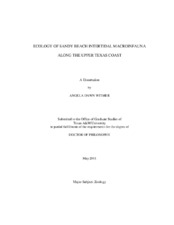| dc.description.abstract | Open coastlines are dynamic environments which experience seasonal and long-term physical changes. Sandy beaches line much of this coastline. As part of the requirements for Ph.D., I conducted a study examining intertidal macrofaunal and sedimentological features along the upper Texas coastal from 2007-2009. Four sites near Sabine Pass, High Island, Jamaica Beach, and Surfside Beach were selected. Beach transects were established at each site with six intertidal stations identified for collecting macrofaunal sediment core samples.
Although sandy beaches are low in species diversity, the taxa found survive under dynamic and harsh conditions. In disturbance dominated environments, sandy beach fauna tended to be influenced by physical factors, instead of biologically controlled ones. The taxa found in this study include primary and secondary successional organisms which are adapted to handle disturbances. 98% of the benthic specimens identified belonged to six taxa with 92% from two taxa, Scolelepis squamata (38%) and Haustoriidae (54%). Macrofaunal zonation varied between sites because of beach geomorphology.
On September 13, 2008, Hurricane Ike made landfall on the upper Texas coast causing extensive damage and erosion. Roughly 0.5 m of vertical height was lost at each beach post-storm. Total macrofaunal abundance declined by 87% from pre-storm counts. During the recovery the dominant two taxa, Haustoriidae and Scolelepis squamata, made up 82.78% of the total benthic specimens identified with haustoriids making up 68% of the total benthic taxa. The beach community remained dominated by four of the previously identified, six most common and abundant taxa.
Recovery of sandy beaches often was hindered by increased vehicular traffic, sand removal and cleaning. Beach ecosystems have shown a high natural ecological resilience, but do not preclude the possibilities of habitat extinction and/or catastrophic community regime shift. Beaches are highly susceptible to human exploitation and global climate change, such as sea level rise. Knowledge of beach macrofaunal diversity along the Texas coast, such as haustoriids, could be used to estimate beach health and better evaluate the upward effects of natural disturbance, pollution and human uses on an integral part of the coastal ecosystem. | en |


